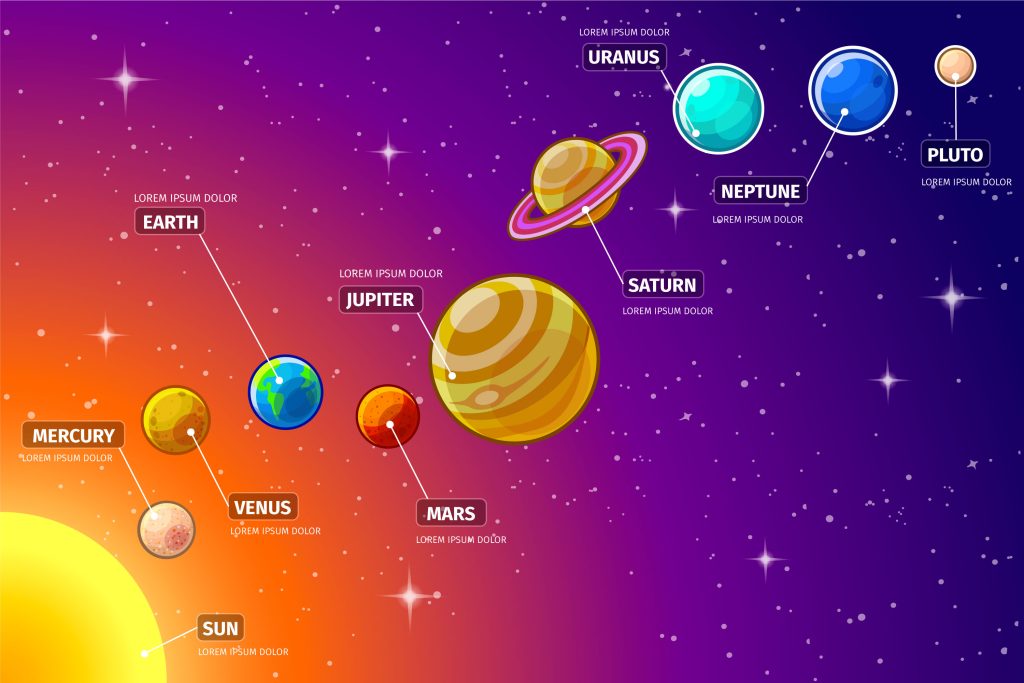
The solar system, our celestial neighborhood, is a captivating expanse of planets, moons, asteroids, and comets, all revolving around a central star—the Sun. This intricate system has fascinated humanity for millennia and continues to unlock mysteries about our place in the cosmos. In this overview, we embark on a journey through space to understand the mechanics and wonders of our solar system.
The Sun: The Heart of Our Solar System
At the center of the solar system lies the Sun, a massive ball of hot, ionized gas that generates light and heat through nuclear fusion. Its immense gravity keeps all the planets and celestial bodies in orbit around it, making it the gravitational anchor of our cosmic neighborhood.
The Inner Planets: Mercury, Venus, Earth, and Mars
Moving outward from the Sun, the first four planets constitute the inner planets.
- Mercury: The closest planet to the Sun, Mercury is a rocky, desolate world with extreme temperature fluctuations between scorching hot days and freezing nights.
- Venus: Often referred to as Earth’s “sister planet,” Venus is a sweltering world with a thick atmosphere of carbon dioxide, making it the hottest planet in the solar system.
- Earth: Our home planet, Earth, is the only known celestial body to support life. Its diverse ecosystems, abundant water, and life-sustaining atmosphere make it a haven for living organisms.
- Mars: Known as the “Red Planet,” Mars boasts a thin atmosphere and is characterized by its rusty surface. Human exploration of Mars remains a significant goal for future space missions.
The Asteroid Belt: A Debris Zone
Between the orbits of Mars and Jupiter lies the asteroid belt, a region containing millions of rocky and metallic objects called asteroids. While popular culture often depicts the asteroid belt as densely packed, the actual distances between asteroids are vast, making space travel through this region feasible and safe.
The Outer Planets: Jupiter, Saturn, Uranus, and Neptune
The four gas giants—Jupiter, Saturn, Uranus, and Neptune—are the outer planets of our solar system.
- Jupiter: The largest planet in the solar system, Jupiter is a gas giant with a powerful magnetic field and a host of moons, including the famous Galilean moons discovered by Galileo Galilei.
- Saturn: Recognizable by its iconic ring system, Saturn is the second-largest gas giant and showcases one of the most stunning and intricate ring structures in the solar system.
- Uranus: Tilted on its side, Uranus rotates uniquely compared to other planets. It is an ice giant with a bluish hue and an intriguing system of rings and moons.
- Neptune: The farthest known planet from the Sun, Neptune is another ice giant with a striking blue coloration. It is known for its dynamic weather systems, including the famous “Great Dark Spot.”
Dwarf Planets and Beyond: Pluto and Beyond
Beyond Neptune lies a region called the Kuiper Belt, which is home to numerous icy bodies, including the dwarf planet Pluto. Once considered the ninth planet, Pluto was reclassified as a dwarf planet in 2006 due to its small size and specific orbital characteristics. Exploring this region and other dwarf planets, such as Eris and Haumea, provides valuable insights into the outer reaches of the solar system.
A Vast Cosmic Symphony
The solar system is a vast and captivating cosmic symphony, where planets, moons, and celestial bodies dance in harmony under the gravitational influence of the Sun. Understanding the mechanics of our celestial neighborhood not only enriches our knowledge of the universe but also fuels humanity’s insatiable curiosity and ambition to explore the cosmos further. As we continue to unravel the mysteries of space, the solar system remains a fascinating canvas on which to paint the grand portrait of our cosmic existence.


